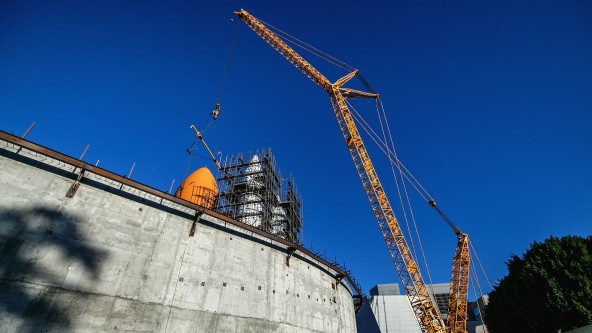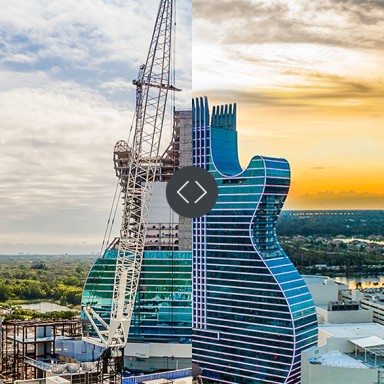
Lifting off in Los Angeles
Lifting off in Los Angeles
The Liebherr LR 1750's capability of electronically limiting the hoist and swing speed was vital to the success of the lifts due to the extremely tight tolerances in the pit and constant wind speed variables at the tip height. When flying priceless NASA artifacts such as the Endeavour and its ancillary support items, it is comforting knowing you have the quality, efficiency and pinpoint accuracy of a Liebherr built product behind you.
Simulating a real-life launch position, Bragg Companies utilize multiple Liebherr cranes to stack all flight certified components of the 20-story Endeavour space shuttle at the Samuel Oschin Air and Space Center within the California Science Center. This is the world’s only authentic space shuttle system displayed in launch configuration.
The space shuttle Endeavour flew 25 missions and has inspired roughly 20 million guests from around the world since arriving at the California Science Center in October of 2012. The 122-foot-long orbiter weighs 178,000 pounds, and has a wingspan of 78 feet.
With over 6,000-man hours including two years of pre-construction engineering and lift planning, Bragg Companies completed the full Endeavour space shuttle stack to simulate a real life launch position in the new Samuel Oschin Air and Space Center. The Oschin building was partially developed prior to stacking all orbiter launch flight components, and it will be completed around the erected launch display.
The full stack includes the Endeavour shuttle as well as two solid rocket boosters each consisting of an aft skirt at the base, a 116 ft solid rocket motor, and a forward assembly on top. The largest component of the stack is a 154 ft external fuel tank. The roughly six-month stack process began in July 2023 with the installation of the aft skirts and was completed in January 2024.
“With the lift and setting of the Endeavour, we have successfully completed the last-ever space shuttle stack. This is a dream over thirty years in the making, and a feat that has never before been accomplished outside of a NASA or Air Force facility,” shared Jeffrey Rudolph, the president and CEO of the California Science Center.

The Liebherr 1750 crawler crane had 1,466,000.00 lbs. of counterweight, a tip height of approximately 395 ft and a max radius of approximately 151 ft.
Setting the shuttle
Bragg used approximately five cranes across each of the lifts. The Liebherr LR 1750/2 crawler crane was on-site full-time with frequent occurrences from various hydraulic truck cranes working concurrently throughout the duration of the project to perform various tasks. The Liebherr LR 1750 crawler crane had 1,466,000.00 lbs. of counterweight, a tip height of approximately 395 ft and a max radius of approximately 151 ft.
“The Liebherr LR 1750's capability of electronically limiting the hoist and swing speed was vital to the success of the lifts due to the extremely tight tolerances in the pit and constant wind speed variables at the tip height,” notes Justin Lambert, general manager of Bragg Crane & Rigging. “When flying priceless NASA artifacts such as the Endeavour and its ancillary support items, it is comforting knowing you have the quality, efficiency, and pinpoint accuracy of a Liebherr built product behind you.”
To kick off the stack process, Bragg loaded and transported the aft skirts from Mojave, CA to Los Angeles, CA, and then utilized the Liebherr LR 1750 crawler crane to lift and set the skirts. Bragg Crane & Rigging then used the crawler crane and the Liebherr LTM 1160 mobile crane to lift, upend and set the solid rocket motors as well as upend and set the external tank into final position.
The largest piece to maneuver was the Endeavour orbiter. After a difficult transport process, the Endeavour was lifted, upended, and set inside the new Samuel Oschin Air and Space Center building using the Liebherr LR 1750 crawler crane with the support of the Liebherr LTM 1400 mobile crane and LTM 1160 mobile crane.
The most challenging part of the stack was attaching the external tank to Endeavour. Placing the tank was arduous as it had to be threaded down through the scaffolding without contacting anything else due to its entire outer layer being foam. Additionally, the tight tolerances of the mating points to the solid rocket boosters made the lift and set difficult.
After almost fourteen hours of work the Endeavour was fully detached from the crane and sling, and the final mating of the space shuttle to the external tank and two solid rocket boosters was complete.

Bragg created twenty engineered plans generated with over 1,400-man hours spent on this lift.
Overcoming obstacles
A project of this magnitude requires precise lift planning months ahead of time. There were approximately twenty engineered plans generated with over 1,400-man hours spent on this lift. However, even with meticulous planning, Bragg had to overcome multiple challenges including tight working areas and weather.
During various lifts, high winds and rain affected the team when picking and setting the units into the new building. Due to the sheer size of the flight components and their large surface areas, all lifting needed to occur in minimal wind conditions. The least amount of wind was during the early hours of the morning, so Bragg Crane & Rigging worked through many nights to complete these complex lifts. Throughout these challenges, the project was completed with zero first aids, incidents, or recordables.
Bragg Companies operates on the same set of standards as they did from their first day in business. The crane, rigging, and heavy haul company operates in all 50 states and remains a leader in the crane, heavy construction, equipment, and transportation industries.

Endeavour’s stack will remain covered by scaffolding, additional plywood and Kevlar fabric throughout the duration of the Air and Space Center construction process.

Due to high winds and pedestrian traffic, Bragg completed many lifts at night or early morning.
Launchpad of innovation
Construction of the Samuel Oschin Air and Space Center, a major expansion of the California Science Center and Endeavour’s permanent home, began in 2022 and will continue around the 20-story shuttle display. Endeavour’s stack will remain covered by scaffolding, additional plywood, and Kevlar fabric throughout the duration of the Air and Space Center construction process.
The future Samuel Oschin Air and Space Center will serve as a launchpad for creativity and innovation to inspire future generations of scientists, engineers, and explorers. The 200,000-square-foot expansion will nearly double the California Science Center’s educational exhibition space, adding an impressive collection of 100 authentic artifacts integrated with 100 new hands-on exhibits.
Liebherr mobile and crawler cranes in the United States
View our extensive range of mobile and crawler cranes, designed for customers, markets, and applications around the world.



